The Five Relics in the Altar
New paintings in the vestibule portray the five saints whose relics are in the altar. The altar and relics were part of an extensive sanctuary renovation in 2015.
The tradition of placing relics in altars goes back to the persecution of Christians in Rome. As early as 125 A.D., Christians crept into the catacombs below the city of Rome to celebrate Mass. Early priests chose the tombs of Christian martyrs as altars.

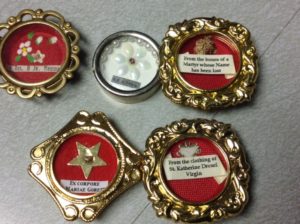
This tradition continues today in most of the altars in Catholic churches around the world. Our altar contains a recess in the mensa (or tabletop) that contains five relics. The relics are sealed under an altar stone.
All but one of our relics are first class relics, meaning that they come from the saint’s body and are usually a small piece of bone or hair. The second class relic is taken from one of the belongings of that saint, often a piece of fabric from the clothing worn by that saint.
Our five relics are especially inspiring for Americans:
- Saint John Neumann, an early American bishop,
- Saint Elizabeth Ann Seton, the first native-born American saint,
- Saint Maria Goretti, a martyr of hospitality,
- Saint Katharine Drexel, the famous American millionaire nun, and
- an unnamed martyr, because altars always contain a martyr’s relics.
The Saint Katharine Drexel relic is a second class relic because her whole body is buried in Saints Peter and Paul Cathedral Basilica in Philadelphia.
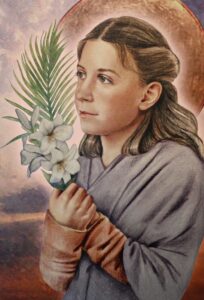 Saint Maria Goretti
Saint Maria Goretti
+1902 Virgin Martyr
Saint Maria Goretti was born in the town of Corinaldo in Italy in 1890. Her neighbor, Alessandro Serenelli, assaulted her, and when she defended her chastity he stabbed her several times. She died the next day, having forgiven her assailant. Having received a vision of Maria Goretti in heaven, Serenelli experienced a profound conversion and would be present in Saint Peter’s Square at her canonization in 1950. A first-class relic of Saint Maria Goretti rests in the main altar of our church. Her feast day is celebrated July 6.
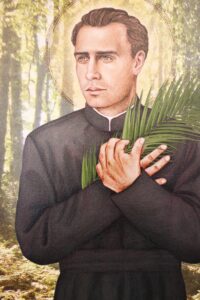 The North American Martyrs
The North American Martyrs
+1642-1649 Martyrs
The North American Martyrs were several French Jesuit priests who died for the faith in the 1640s. The “Black Robes” came to Canada and upstate New York to proclaim the Gospel to the native peoples, but were caught up in the conflict between the Huron and Mohawk Iroquois tribes. Among the priests martyred were Saint Isaac Jogues and Saint Jean de Brebeuf. A first-class relic of one of the North American martyrs (identity uncertain) rests in the main altar of our church. The martyrs’ feast day is celebrated October 19.
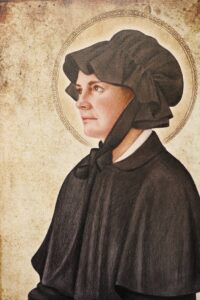 Saint Elizabeth Ann Seton
Saint Elizabeth Ann Seton
+1821 Holy Woman and Religious Founder
Saint Elizabeth Ann Bayley Seton was born in New York in 1774 and married the businessman Willam Seton in 1794. After his death abroad in Italy, she joined the Catholic Church in 1805 upon returning to the United States. She would go on to found the Sisters of Charity of St. Joseph in Emmitsburg, Maryland, and established schools for children which became the model for Catholic parochial education. A first-class relic of Saint Elizabeth Ann Seton rests in our main altar. Her feast day is celebrated on January 4.
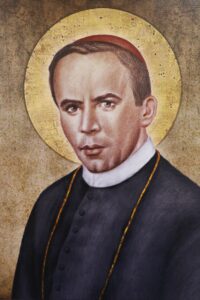 Saint John Neumann
Saint John Neumann
+1860 Bishop
Saint John Neumann was born in what is now the Czech Republic in 1811. He completed seminary studies in Europe and traveled to the United States in 1836, where he was ordained a priest for the Diocese of New York. He eventually joined the Redemptorist religious order and was named Bishop of Philadelphia in 1852. Renowned for his charity, holiness, care of immigrants, and promotion of Catholic schools, St. John Neumann was canonized in 1977. A first-class relic rests in our altar, and his feast day is celebrated on January 5.
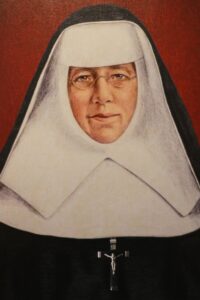 Saint Katharine Drexel
Saint Katharine Drexel
+1955 Virgin and Religious Founder
Saint Katharine Drexel was born in Philadelphia in 1858, the second daughter of a wealthy banker. Her parents instilled deep religious and moral principles in their daughters. Upon receiving a substantial inheritance from them, Saint Katharine Drexel decided to establish a religious community, the Sisters of the Blessed Sacrament, to minister to black and indigenous peoples of the United States. She funded many institutions to that purpose, including several in Oklahoma. A second-class relic (a portion of her habit) rests in the main altar of our church. Her feast day is celebrated on March 3.